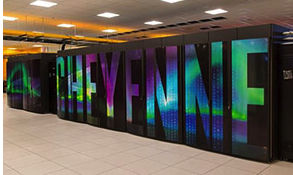University of Wyoming Faculty Has Until June 21 to Apply for Supercomputer Use
To request large core-hour allocation on Cheyenne, current HPC at Wyoming Supercomputing Center
This is a Press Release edited by StorageNewsletter.com on June 3, 2019 at 2:18 pmUniversity of Wyoming faculty members who are interested in using the National Center for Atmospheric Research (NCAR)-Wyoming Supercomputing Center (NWSC) in Cheyenne for their computational research have until June 21 to submit an application to request a large core-hour allocation on Cheyenne, the current supercomputer at the NWSC.

“A plan describing the flow and management of the data throughout the project, and the plans for retaining and sharing appropriate portions of the data is a critical part of the request,” says Bryan Shader, a UW mathematics professor who also serves as co-chair of the Wyoming-NCAR Alliance Resource Allocations Panel (WRAP), a group that evaluates requests for large allocations on NWSC’s supercomputers.
In recognition of the increasing importance of amounts and costs of data, each allocation request must include detailed justifications for the amount of space requested on the various storage systems described below.
GLADE is a central file and storage resource, and should be used to facilitate the generation of model output on Cheyenne, followed by the analysis and visualization of the output on separate NWSC systems. The NCAR campaign storage file system is available for storage of data on publication timescales and should not be used for development work. The High Performance Storage System (HPSS) should be used to archive critical scientific data over the longer term.
Cheyenne is one of the world’s most powerful commercial supercomputers with 5.33 petaflops. This means that Cheyenne is capable of performing over 5 quadrillion basic mathematics operations per second. Cheyenne was ranked as 36th on the Top500 Supercomputer list and 71st among the Green500 list. Cheyenne uses the Silicon Graphics’ ICE XA system and is designed to enable scientists, researchers and engineers to better understand earth and atmospheric systems, and use that understanding to solve grand challenges, such as drought and extreme weather events, impacting our world.
Wyoming’s allocation of the NWSC resources is currently 160 million core hours of computing per year. Any request for more than 400,000 core hours is considered a large request. One core hour is the equivalent of running one application on a single computer for one hour.
“Last year, there were 32 UW projects on the NWSC. This level of usage ranked Wyoming as No. 1 in total allocations and usage, and No. 3 in active projects of the NWSC among universities,” Shader says.
Applications and allocation information can be accessed. The research must lie in earth system science or atmospheric science, which is broadly defined. A list of eligible science areas is available. A PowerPoint presentation that offers suggestions on how to write a competitive proposal is available.
Successful allocation requests include benchmarking studies on a smaller scale and on a smaller computer. These benchmark studies can be performed using Mount Moran, the nickname for UW’s Advanced Research Computing Center (ARCC).
The NWSC is the result of a partnership among the University Corporation for Atmospheric Research (UCAR), the operating entity for NCAR; UW; the state of Wyoming; Cheyenne LEADS; the Wyoming Business Council; and Black Hills Energy. The NWSC is operated by NCAR under sponsorship of the National Science Foundation.
The NWSC is dedicated to improving scientific understanding of climate change, severe weather, air quality and other vital atmospheric science and geoscience topics.
The center also houses premier storage systems (52.7PB in the GLADE system, 20PB in the campaign storage system and a capacity of over 320PB of HPSS).














 Subscribe to our free daily newsletter
Subscribe to our free daily newsletter

